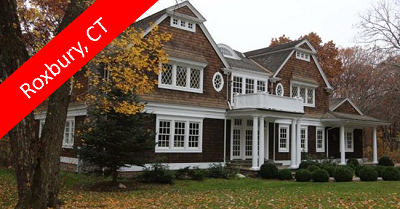Archive for August 2013
Future Energy Trends
Deborah Laemmerhirt 203-994-4297 HomesInConnecticutForSale.com Electric utilities are advancing in their programs to swap out old inefficient power meters with new 2 way devices. With new metering capabilities homeowners will have powerful options in energy usage and management. The big buzz now trending is time-of-use, or dynamic electricity pricing. Most homeowners today pay a one-size-fits-all price…
Read MoreImprove Your Connecticut Home Energy Scores!
Deborah Laemmerhirt 203-994-4297 HomesInConnecticutForSale.com
Most adults remember hearing their parents complain if doors and windows were left open: “I’m not paying to heat the whole neighborhood!” Now that you’re paying the bills, you understand.
But even without children to run up the bills, there’s a good chance that the power you are paying for is slipping right through the walls, windows and doors out to heat (or cool) the neighborhood.
So it may be time to curb your home’s appetite for energy so you can lower your bills and be more comfortable.
The U.S. Department of Energy points out that most energy-efficient homes share these basic elements:
- Controlling ventilation. Energy-efficient homes are tightly sealed, therefore it’s vital to include adequate ventilation in the design to prevent indoor pollution and reduce the likelihood of mold.
- Having a properly sized, high-efficiency heating and cooling system. A too big or too small system either works too hard or over-produces, which wastes power. Some energy-efficient systems require only sunshine as the primary heat source, along with auxiliary warmth from radiant-in-floor heating or a standard source such as an electric heat pump.
- In hotter climates, a cooling system might include the use of light-colored exterior siding or paint, which can reduce cooling requirements up to 15 percent, and the selection and placement of vegetation.
- Installing energy-efficient windows, doors, and appliances. Since most homes lose 25 percent of their heat through windows — even modern windows allow some heat loss — window placement is key to retaining heat. For example, in a cold climate, some builders recommend having most of the windows on the southern side of the house to take advantage of the sun, and few on the north, east, and west sides of the home. In heat-intensive climates, window overhangs can help reduce the sun’s rays. And using Energy Star label windows and doors provides twice as much energy efficiency as products made as recently as 10 years ago.
- Making sure the “thermal envelope” is well-constructed and tightly sealed. A thermal envelope includes all aspects of a house that shield the living space from outside. The walls, roof, windows, weather stripping, caulking, insulation, and air and vapor retarders are important factors in ensuring efficient use of heating and cooling.
- Often, the key to a home’s energy-efficiency has more to do with the quality of the construction and installation than with the quality of the materials. For example, while most newer homes have adequate insulation, it may be poorly installed, resulting in gaps and general sloppy protection.
With new homes and additions, you should determine which design provides the most efficient use of energy and takes advantage of natural sources of energy. For this purpose, the placement of windows, doors and the heating/cooling systems is critical.
Computer software programs can also help evaluate what insulation is required, how to deal with moisture dynamics, and of course, the aesthetics of a home.
The Role of the Government
The federal government promotes the construction of energy-efficient homes through its Building America and Energy Star Homes programs. There are also many local programs available to provide incentives for energy consciousness. That’s why, if you are looking to purchase a newly built home or remodel an existing one, there’s a good chance you can find local builders and contractors that participate in energy-saving programs and incorporate smart energy features into their design and construction. Contractors may display energy-efficient symbols along with their logos on building site signs.
You may even be able to buy or refinance your home with an energy-efficient mortgage, which is a federally recognized loan that provides special benefits to borrowers or sellers of homes that are, or can be made, energy efficient.
Nobody wants to throw away money paying higher-than-necessary utility bills or be too hot or cold. Having an energy-efficient home helps promote both of those goals. Energy-efficiency takes some planning, some initial expense, and possibly some remodeling. But time will repay your efforts and cost with a home that is more economical to operate, more welcoming to live in, and more valuable when it comes time to sell.
Read MoreIf Your Mortgage Is Rejected!
Deborah Laemmerhirt 203-994-4297 HomesInConnecticutForSale.com
Mortgage applications get denied… it happens every day. If it happens to you, you can give up the dream of home ownership, or take a proactive approach and fix whatever problems caused the rejection.
When lenders turn down a loan application, they are required to tell you why. That requirement is intended, in part, to keep lenders from making loan decisions based on discriminatory factors such as race or gender. But it also provides applicants with the information they need to strengthen their overall financial situations.
Give Your Loan Application the Best Chance for Approval
- Employment stability is a big part of the picture when you are asking someone to trust you with a decades-long year mortgage. If you’ve been at your current job for less than two years but have been in the same industry for a longer period, be sure you note that in your application.
- Before you apply for a loan, get a copy of your credit report (you may want to get copies from each of the three reporting bureaus, since they may contain different information). Check it for inaccuracies and outdated information. It can take 30 days or more to correct errors, so start early.
- If extraordinary circumstances like a job lay-off or medical emergency have created temporary bill-paying problems in the past, explain this to the lender.
- Provide documentation that the lender asks for as soon as possible. If you’re too busy to get the paperwork together and answer whatever questions the lender has, it may be a good idea to wait until you can do what it takes to push the application through. Lenders have three days from the day you file your application to give you a Good Faith Estimate of the fees that will be due at closing. If you fill out an application and then don’t give the lender the necessary information right away, he or she may have no choice but to close the application process.
First, you should know how the basic process works. When you apply for a mortgage, here’s what to expect:
- You will receive an approval or rejection within 30 days of submitting a completed application.
- If your application is denied, your lender must tell you, in writing, specifically why you were not approved (or give you have 60 days to ask the reasons for the rejection). It’s not enough for lenders to say “you didn’t meet our standards.” They must provide details such as “not enough time on the job,” or “your income is too low.” Once you know where your financial weaknesses are, you can focus on fixing the problems.
- Your mortgage may have been approved, but on less favorable terms than you originally applied for. In that case, lenders must tell you why you didn’t qualify for better terms (if you ask), but only if you turn down the counter offer, according to the Federal Trade Commission.
- If your mortgage was rejected because of something in your credit report, the lender is required to tell you how to contact the credit bureau that issued the report. If you ask within 60 days, the bureau will provide you with a free copy of your report. Plus, under the Fair Credit Reporting Act, all consumers are entitled to receive one free report each year, which you can get order visiting the annualcreditreport.com Web site. If there is inaccurate information in your credit report, the credit bureau must investigate if you file a dispute. The company that provided the inaccurate information must also reinvestigate your claim and report the findings. If, after the investigation the inaccurate information remains and you still dispute it, include a summary of your position in your credit file.
- A poor appraisal may all or part of the reason for your mortgage denial. Ask the lender for a copy and check it for inaccuracies such as age, location, and dimensions of the home. Also verify that there was no illegal component to the appraiser’s decision, such as the racial makeup of the neighborhood. The appraiser works directly or indirectly for your lender, so if there are factual errors, or illegal information in the appraisal, point these things out to your lender and ask him or her to contact the appraiser.
Depending on the reason for the mortgage denial, it may just be a matter of time, or you may need to take action. If you’ve made a habit of job hopping, settle down and stick with one employer long enough to develop a stable history. If your credit history is shaky, stop opening new accounts and make a concerted effort to pay down the ones you have. Keep balances on all accounts low, since part of your credit score depends on how much of your available credit you are using. Pay bills on time. If you have old credit accounts with zero balances, don’t close them or you could negatively impact your credit score. Keep them open and cut up the credit cards.
Barring unforeseen circumstances such as a medical emergency or a job lay off, anyone can become creditworthy with time and diligence.
Read More9 Deep Woods Lane, Home For Sale In New Milford, Connecticut!
9 Deep Woods Lane, Home For Sale In New Milford, Connecticut Overview Maps Photos Neighborhood $599,000 Single Family Home Main Features 5 Bedrooms 3 Bathrooms 1 Partial Bathroom 2 Units Interior: 3,530 sqft Lot: 7.44 acre(s) Location 9 Deep Woods New Milford, CT 06776 USA To get updates on open home dates and other…
Read More67 Tophet Road, Home For Sale In Roxbury, Connecticut!
67 Tophet Road, Home For Sale In Roxbury, Connecticut Overview Maps Photos Description Neighborhood $1,650,000 Single Family Home Main Features 4 Bedrooms 6 Bathrooms 2 Partial Bathrooms 1 Unit Interior: 7,317 sqft Lot: 6.00 acre(s) Location 67 Tophet Road Roxbury, CT USA To get updates on open home dates and other property events, please…
Read More25 High Meadow Lane, Home For Sale In Roxbury, Connecticut!
25 High Meadow Lane, Home For Sale In Roxbury, Connecticut Overview Maps Photos Features Description Neighborhood $1,750,000 Single Family Home Main Features 5 Bedrooms 4 Bathrooms 1 Partial Bathroom Interior: 6,000 sqft Lot: 42.00 acre(s) Location 25 High Meadow Lane Roxbury, CT 06783 USA To get updates on open home dates and other property…
Read MoreSave Thousands Of Dollars When You Buy A Home!
Click Here For Your FREE Home Buyers Report!
Read MoreWhat’s Your Home Worth? Free Quick Over-the-Net Home Evaluation
Click Here For Your FREE Over the Net Home Valuation!
Read MoreHow to STOP Paying Rent and OWN Your Own Home
Click Here For Your FREE Report and STOP Paying Rent!
Read MoreCONSIDER DOLLAR COST AVERAGING
Deborah Laemmerhirt 203-994-4297 HomesInCommecticutForSale.com
We all know we should buy low and sell high, but determining when that occurs is difficult. Thus, consider using a strategy like dollar cost averaging to help with those decisions.
Dollar cost averaging involves investing a set amount of money in the same investment on a periodic basis. For instance, instead of investing a lump sum in one stock immediately, you might invest $2,000 in that stock at the beginning of every month.
Utilizing this strategy can provide several benefits:
- Dollar cost averaging requires the discipline to invest consistently, regardless of market fluctuations. Thus, it reinforces the habit of regularly setting aside money for investing.
- For many investors, one of the more difficult aspects of implementing an investment strategy is deciding when to invest. Fear of investing at a market high can keep investors waiting on the sidelines for some indication of when they should invest. With a dollar cost averaging program, you just follow the plan and invest on a periodic basis, without trying to time the market.
- Since you are investing a fixed amount of money, you purchase more shares when prices are lower and fewer shares when prices are higher. Thus, your average cost per share is typically lower than the average market price per share over the same time period.
- A dollar cost averaging program is by definition a long-term program. Thus, if followed consistently, it helps encourage long-term investing.
- Since you are spreading your investment over a period of time, it keeps you from investing all your money at a market high.
Dollar cost averaging, however, does not ensure a profit or protect against loss in declining markets. Before starting a dollar cost averaging program, you should consider your financial ability to continue purchases through periods of low price levels.
You may already be using a dollar cost averaging program without realizing it ? participating in a 401(k) plan, reinvesting dividends in additional shares, or automatically transferring funds from your bank account to an investment account are all forms of dollar cost averaging.
Read More










